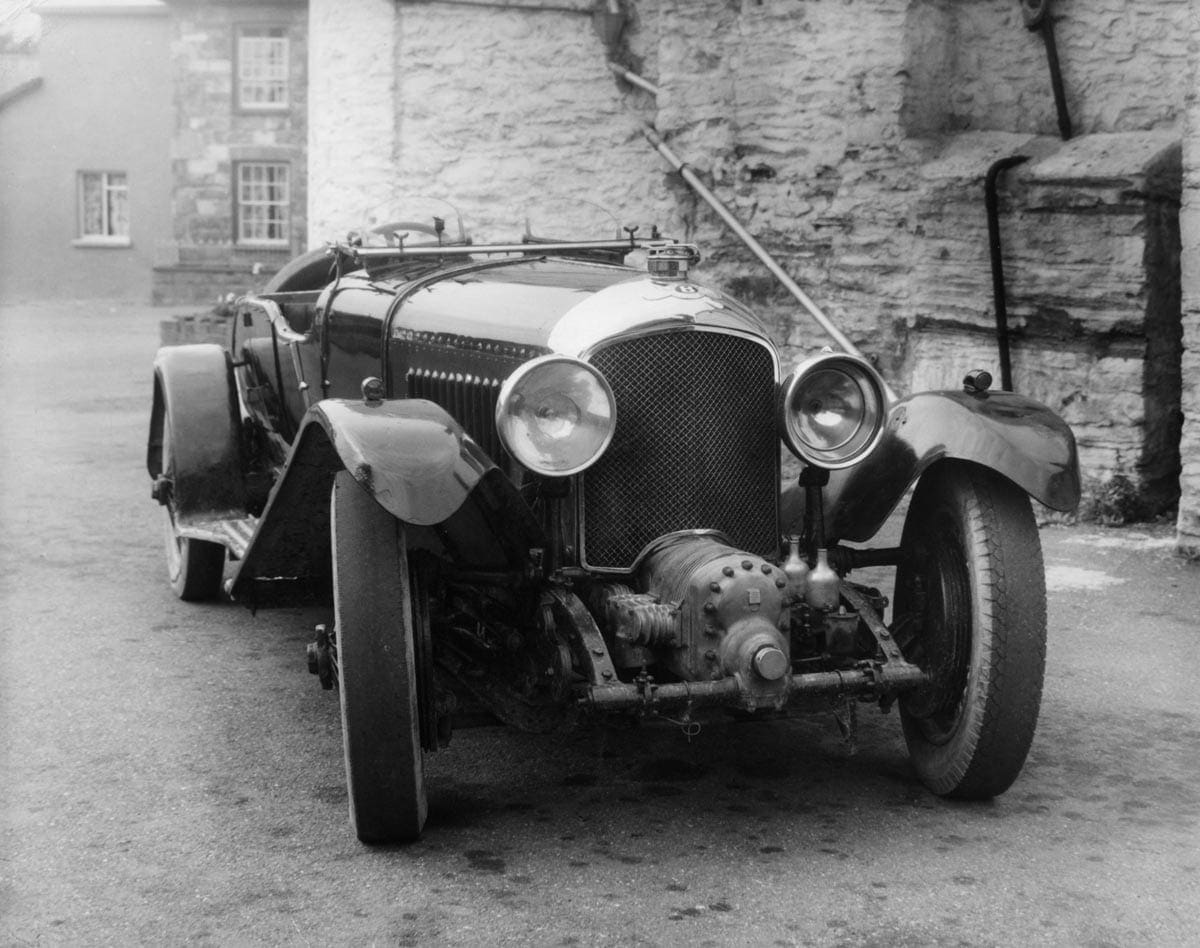Our car won the Isle of Man time trial in 1931. This “Blower Bentley” keeps its original engine, chassis, and body. It has a massive supercharger at the front.
THESE CARS
The history of great racing Bentleys is well known. From 1927 to 1930, they were unbeatable in endurance racing, having won Le Mans successfully during those four years with first, a 3 liter, then a 4.5 liter, and finally, the speed 6 in 1929 and 1930. To get even more horsepower from the great four cylinder 4.5 liter car, adding a supercharger was considered, since it was already used successfully by Bugatti, Alfa Romeo and others. There is an oft-repeated story that W. O. Bentley himself opposed this method of getting additional power. He favored increasing engine size. The story goes it was Sir Henry Birkin, sponsored by the Honorable Dorothy Paget, to whom Mr. Bentley finally relented and made the 50 obligatory cars for sale to the public, and five special racing type cars.
The supercharger operates on Roots principles, with two synchronized twin lobe rotors. The boost given was 10 PSI from 25 miles an hour in top gear and does not exceed 11 PSI at the highest engine speeds. With this engine and a light single seater body, the car established the Brooklands Outer Circuit Record at 137.9 miles per hour. These cars were impressive in their power and speed, but were yare and therefore unsuccessful racing cars. Even in local British Racing Drivers Club competition, they usually retired in the 500 mile race with one noteworthy second place finish in 1930. Because a supercharged Bentley traveled the fastest on the Brooklands banked circuit the “Blower” will forever represent a British symbol of powerful motoring, It’s pyknic image in Rexene-clothed, cycle-fender, bells-and-whistled armor, with the ponderous blower menacing aft is a symbol of the manly British bolide.
OUR CAR
This car was ordered by T. G. Moore and registered in 1931, donned in a Vanden Plas built a special aluminum tourer body. Specified on the original build sheet are the design features that are still on the car. The doors were to come down to the frame rails, not the half doors so commonly seen on Vanden Plas bodies. The running boards were to be in line with the center of the wheel hubs. The body was to be fully valanced, which means the front fenders extended to the side of the body and, in addition, the frame rails were louver covered from front fender to rear fender. They would paint the body Le Mans green (whatever that was) with the matching upholstery and a dark walnut dashboard.
T.G. Moore, who just took over Motorsport Magazine as its publisher, must have been very proud of his new car. It is likely that he took it to a variety of events, but the most notable was featured in page 383 of the Motorsport Magazine of April 1931. He won the timed trial of the Isle of Man with a speed of 62.33 miles an hour. This was significantly better than the competitors. Exactly how the trial was conducted in this case was unknown. Sometimes, there was a flying start over a specified distance, whereas at other times the timing started from a dead stop. This proud showing was most likely repeated because, ultimately, it was registered again in the Isle of Man while still under Moore’s ownership.
Later, it went through several hands and was later discovered after the war in Aylesbury by U.S. serviceman Robert K. Carter who shipped it to the USA via an armed forces vessel. Mr. Carter had every intention of restoring the car, but as time went on, this became evident that it was not going to happen.
We were looking for that nearly extinct beast, a blower with its original body; the majority of the survivors were now re-invented as boy racers. We bought her from Mr. Carter in 1981 and started and started a restoration. The car was in remarkably preserved condition though did not have top bows, (nor does it have them now). Other than that, nothing was seriously missing. The rear end had been cut back a bit, but this was easily restored. Beyond this, all external metal was original. There were no missing instruments. The original engine and the D-type gearbox were intact and really did not require much internal fettling although they were refreshed. The sump had to have repairs simply because oil had been laying in it for decades and this ate through the metal in some spots.
Jim McHenry of the Ball and Ball Shop in West Chester, Pennsylvania did the mechanical work. Jim and I had an excellent working relationship, and he understood our exact needs. He did a superb job on the engine and transmission. The work on the rear of the body was finished and then sent to Fred Hoch of Schaeffer & Long for paint. David George, functioning in his usual versatile way, did a superb upholstery job exactly according to Bentley standard.
Today, she runs well, but she is no gem in the handling department. The heavy front end resists cranking in contrast to the litheness of the 3-liter. But the sight and sound of the always exposed blower motivates the effort.

Bond’s car was his only personal hobby. One of the last of the 4½-litre Bentleys with the supercharger by Amherst Villiers, he had bought it almost new in 1933 and had kept it in careful storage through the war. It was still serviced every year and, in London, a former Bentley mechanic, who worked in a garage near Bond’s Chelsea flat, tended it with jealous care.
Sir Ian Fleming – Casino Royale












